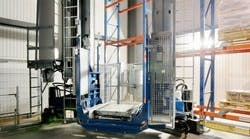Automated storage and retrieval systems (AS/RS) are computer-controlled material handling machines for automatically depositing, storing and retrieving unit loads from defined storage locations. Central to the AS/RS is its stacker cranes which permit full-pallet load and layered-pallet inventory to be moved quickly, safely and precisely within a high-bay warehouse environment.
Stacker cranes offer reliability and accuracy. Modern cranes operate within a set of top and bottom rails, eliminating the need for any flat-floor requirements. Since the crane is stabilized by the rail connections, greater load capacities are available, as well as higher rack heights, when compared to free roaming lift trucks.
AS/RS cranes have a high efficiency of cycle time, a calculation of the movement of product within a DC’s storage system. Many manual operations in a warehouse transport product in only one direction, then return with an empty load. Stacker cranes place a load into a rack position, and then retrieve a load from storage on their way back out, optimizing the crane’s movements.
The AS/RS stacker crane concept has proven itself to be a viable method of reducing operating and distribution costs in the warehouse. Semi-automated and fully-automated cranes reduce the number of people required to operate the warehouse. By incorporating stacker crane systems, a distribution center’s throughput can operate at a more cost-efficient level.
The latest generation of AS/RS cranes allows single-deep, double-deep, triple-deep and up to 20-deep pallet stacking utilizing telescopic forks and shuttle cars, with the flexibility to handle one load at a time or multiple loads.
Such cranes can exceed 140 feet in height carrying payloads of 11,000 pounds, traveling at vertical speeds of 325 feet-per-minute (FPM) and achieving horizontal travel speeds of 787 FPM.
Most can operate in a wide range of temperatures, from minus 38° F to 140° F, equipped with wiring, electrical cables and photo-electronic sensors designed to withstand these extreme environments.
High-speed PLCs with integrated controls architecture monitor the movements of the cranes. Receiving directions from the distribution center’s warehouse management system (WMS) and warehouse control system (WCS) via Ethernet, the cranes use barcode technology to direct their movement in the high-bay and the crane’s movement of pallets.
A/C powered stacker cranes eliminate the costs associated with DC batteries, charging, and associated maintenance. Such cranes have also eliminated hydraulics, which greatly reduces maintenance costs.
And then there is power-saving technology. As the crane carriage lowers, software allows the power to be captured from the lifting motor, which now becomes the generator. That captured power can be put into a grid inside the distribution center to help power other equipment like conveyor systems or other stacker cranes.
Aisle-changing functionality can reduce the number of cranes, enabling the number of stacker cranes to be matched to warehouse throughput instead of to the number of aisles—therefore reducing the capital investment.
One such crane design (LTW Intralogistics, www.ltwusa.com) enables the crane, once it gets to the end of an aisle, to then travel perpendicular to the aisle and enter another aisle to continue storing and retrieving pallets. It rotates around the end of the aisle on a curved track, without leaving the track. This increases redundancy if a crane goes out of service.
Depending on the throughput flow of a distribution center, the DC may employ a combination of dedicated-aisle cranes for aisles with higher volume throughput requirements, and use aisle-changing cranes for those aisles where the volumes are less.
Patrick Roberts writes on logistics automation.




